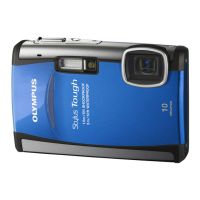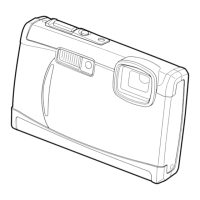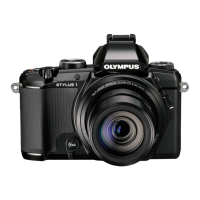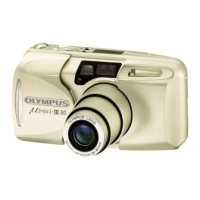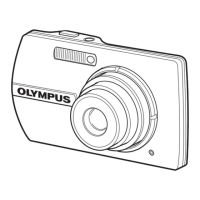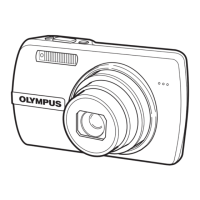• Taking
pictures
using
exposure
compensation
(p.23)
Adjust the brightness while viewing the screen
for taking the picture. Normally, taking pictures of
white
SUbjects
(such as snow) results
in
images
that are darker than the actual subject. Use the
IB
button
to
adjust
in
the positive (+) direction
to
express whites
as
they appear. When taking
pictures of black subjects,
on
the other hand, it
is
effective
to
adjust
in
the negative H direction.
"Taking
pictures
with
colors
at
the
same
shade as
they
appear"
• Taking
pictures
by selecting [WB] (p. 30)
Best results
in
most environments can normally
be obtained with the AUTO setting, but for some
SUbjects,
you should try experimenting with
different settings. (This
is
especially true for
sunshade under a clear sky, mixed natural and
artificial light settings, and so on.)
,"mage.:ti~iI/ity
\
.. S r
~
..
,
;h~F,:\,
~~.'
CoforhiJe
"Taking
pictures
(or
movies)
without
camera
shake"
• Taking pictures
using
[IMAGE STABILIZER]
(p.32)
When a picture
is
taken of a shadowy subject, the
CCO'! shifts
to
correct for camera shake even if
the ISO speed
is
not increased. This function
is
also effective when taking pictures at a high zoom
magnification.
'1 A device that takes light received through the
lens and converts it into electric signals.
•
Shooting
movies
using
[DIS MOVIE MODE]
(p.32)
• Taking picture
with
[~
SPORT] (p. 33)
Since you can take pictures with a high shutter
speed by setting
[~
SPORn,
it's also effective for
blurry subjects.
• Taking
pictures
at
a
high
ISO
sensitivity
If a high ISO sensitivity
is
selected, pictures can
be taken at a high shutter speed even at locations
where a flash cannot be used.
Camera shake
[ISO]
(p.
30)
"Taking
pictures
with
the
right
brightness"
• Taking
pictures
of
a
subject
against a
backlight
A face against the backlight
is
brightened.
[SHADOWAOJ]
(p.
33)
• Taking
pictures
using
[FACE DETECT]
for
[AF MODE] (p. 32)
Appropriate exposure
is
obtained for a face
against the backlight. and the face
is
brightened.
• Taking
pictures
using
[0]
for
[ESP/C!:J] (p. 32)
The picture can be taken based
on
the brightness
at the center
of
the monitor, so it's not affected by
the light
in
the background.
• Taking
pictures
using
[FILL IN] (p. 23) flash
A subject against a backlight
is
brightened.
• Taking
pictures
of
a
white
beach
or
snow
scene
Set the mode
to
[fJ'~
BEACH & SNOW],
[8 SNOW]
(p.
33)
"Taking
sharper
pictures"
• Taking pictures
with
the
optical
zoom
Avoid using [DIGITAL ZOOM]
(p.
31) to take
pictures.
• Taking
pictures
at a
low
ISO
sensitivity
If the picture is taken with a high ISO sensitivity,
noise (small colored spots and color unevenness
that were not
in
the original image) can occur, and
the image can appear grainy.
[ISO)
(p.
30)
"Taking
pictures
so
that
the
frames
are
stitched
smoothly"
• A
tip
for
panoramic
shooting
Taking pictures by pivoting with the camera at the
center prevents shifting
of
the image. When taking
pictures of close objects
in
particular, pivoting with
the lens end at the center produces favorable
results.
[t:::!
PANORAMA]
(p.
34)
EN
• Taking
pictures
using
exposure
compensation
(p.23)
Adjust the brightness while viewing the screen
for taking the picture. Normally, taking pictures of
white
SUbjects
(such as snow) results
in
images
that are darker than the actual subject. Use the
IB
button
to
adjust
in
the positive (+) direction
to
express whites
as
they appear. When taking
pictures of black subjects,
on
the other hand, it
is
effective
to
adjust
in
the negative H direction.
"Taking
pictures
with
colors
at
the
same
shade as
they
appear"
• Taking
pictures
by selecting [WB] (p. 30)
Best results
in
most environments can normally
be obtained with the AUTO setting, but for some
SUbjects,
you should try experimenting with
different settings. (This
is
especially true for
sunshade under a clear sky, mixed natural and
artificial light settings, and so on.)
,"mage.:ti~iI/ity
\
.. S r
~
..
,
;h~F,:\,
~~.'
CoforhiJe
"Taking
pictures
(or
movies)
without
camera
shake"
• Taking pictures
using
[IMAGE STABILIZER]
(p.32)
When a picture
is
taken of a shadowy subject, the
CCO'! shifts
to
correct for camera shake even if
the ISO speed
is
not increased. This function
is
also effective when taking pictures at a high zoom
magnification.
'1 A device that takes light received through the
lens and converts it into electric signals.
•
Shooting
movies
using
[DIS MOVIE MODE]
(p.32)
• Taking picture
with
[~
SPORT] (p. 33)
Since you can take pictures with a high shutter
speed by setting
[~
SPORn,
it's also effective for
blurry subjects.
• Taking
pictures
at
a
high
ISO
sensitivity
If a high ISO sensitivity
is
selected, pictures can
be taken at a high shutter speed even at locations
where a flash cannot be used.
Camera shake
[ISO]
(p.
30)
"Taking
pictures
with
the
right
brightness"
• Taking
pictures
of
a
subject
against a
backlight
A face against the backlight
is
brightened.
[SHADOWAOJ]
(p.
33)
• Taking
pictures
using
[FACE DETECT]
for
[AF MODE] (p. 32)
Appropriate exposure
is
obtained for a face
against the backlight. and the face
is
brightened.
• Taking
pictures
using
[0]
for
[ESP/C!:J] (p. 32)
The picture can be taken based
on
the brightness
at the center
of
the monitor, so it's not affected by
the light
in
the background.
• Taking
pictures
using
[FILL IN] (p. 23) flash
A subject against a backlight
is
brightened.
• Taking
pictures
of
a
white
beach
or
snow
scene
Set the mode
to
[fJ'~
BEACH & SNOW],
[8 SNOW]
(p.
33)
"Taking
sharper
pictures"
• Taking pictures
with
the
optical
zoom
Avoid using [DIGITAL ZOOM]
(p.
31) to take
pictures.
• Taking
pictures
at a
low
ISO
sensitivity
If the picture is taken with a high ISO sensitivity,
noise (small colored spots and color unevenness
that were not
in
the original image) can occur, and
the image can appear grainy.
[ISO)
(p.
30)
"Taking
pictures
so
that
the
frames
are
stitched
smoothly"
• A
tip
for
panoramic
shooting
Taking pictures by pivoting with the camera at the
center prevents shifting
of
the image. When taking
pictures of close objects
in
particular, pivoting with
the lens end at the center produces favorable
results.
[t:::!
PANORAMA]
(p.
34)
EN
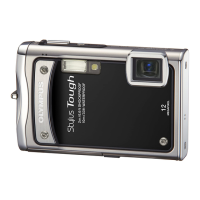
